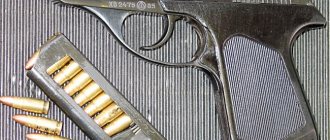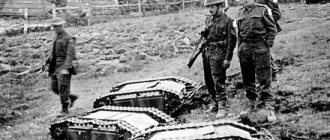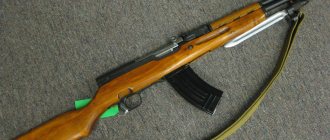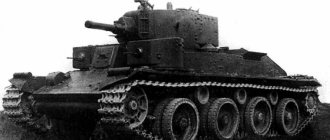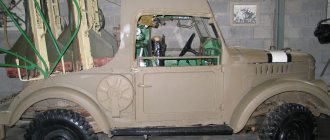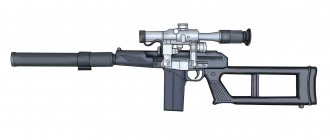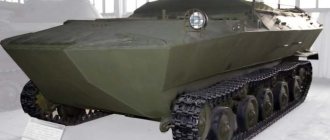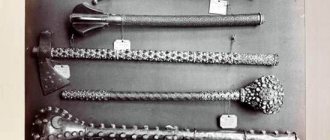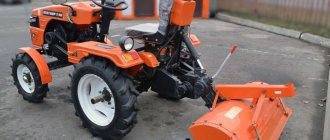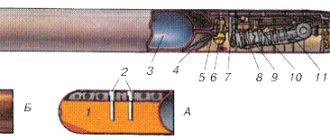For the term "Torpedo" see also other meanings.
Launching a torpedo from a Virginia-class submarine (artist's drawing) Torpedo compartment on the French nuclear submarine Le Redoutable Soviet torpedo from the Second World War, Malaya Zemlya Museum-Reserve, Novorossiysk
Torpedo
(from lat. torpedo narke - electric rays, abbreviated lat. torpedo) - a self-propelled underwater combat projectile. A naval torpedo consists of a cylindrical streamlined body with tail and propellers, or with a jet nozzle in the tail (torpedo missile). The warhead of a torpedo contains a nuclear or non-nuclear warhead, fuel, engine and control devices (including targeting).
The most common caliber of naval torpedoes (hull diameter at its widest part) is 533 millimeters (21 inches) (samples from 254 to 660 mm are also known). The average length (for universal torpedoes) is about 7 meters, weight (for universal torpedoes) is about 2 tons, the explosive charge (for universal torpedoes) is 200-400 kilograms.
Naval torpedoes are in service with surface (torpedo boats, destroyers and others) and submarine ships, airplanes and helicopters, and as an integral part of anti-submarine missile systems.
To this day, naval experts admire the foresight of F. Engels, who, in the year of the appearance of new weapons in the book “Anti-Dühring” (1873), wrote: “ In the competition between armor and guns, a warship has been brought to such a brink of sophisticated perfection when it becomes as much unaffordable as it is unsuitable for war... The improvement of the self-propelled torpedo, the latest product of large-scale naval industry, seems designed to accomplish this: the smallest torpedo boat will then be stronger than the largest armadillo
" [Torpedoes_1986(3)]
The development of the torpedo was accompanied by the solution of technical problems by several generations of inventors. The newest problems of torpedo development are still awaiting their constructive and scientific solution. [Torpedoes_1986(3)]
Origin of the term
In the Russian language, the word “torpedo” was found already in 1864 [1], even before the invention of I. F. Aleksandrovsky. But then it did not mean a self-propelled device, but a sea mine (in the original - “an underwater vehicle used to blow up ships”).
In 1865 (a year before Whitehead patented the torpedo), I. F. Aleksandrovsky used the term “self-propelled torpedo” regarding his invention [2]. Later, this term did not catch on, and until 1917 and the reform of the army, torpedoes in the Russian fleet were called “self-propelled mines”, “Whitehead mines”, and torpedo operators were called “miners”.
In the Russified form of “torpedoes ”
"The term has been used in print since at least 1877[3][4][1].
There is no consensus regarding the first use of this term in English. Some authoritative sources[5][6] claim that the first recording of this term dates back to 1776 and it was introduced into circulation by David Bushnell, the inventor of one of the first prototype submarines, the Turtle. According to another, more widespread version[1], the primacy of the use of this word in the English language belongs to Robert Fulton and dates back to the beginning of the 19th century (no later than 1810[7])
In both cases, the term “torpedo” did not denote a self-propelled cigar-shaped projectile, but an egg- or barrel-shaped underwater contact mine[8], which had little in common with the Whitehead and Aleksandrovsky torpedoes.
Originally in English, the word “torpedo” refers to electric stingrays, and has existed since the 16th century and was borrowed from the Latin language (lat. torpedo), which, in turn, originally meant “numbness,” “rigidity,” “immobility.” The term is associated with the effect of the “impact” of an electric ramp[5].
Destruction of sea mines
To combat sea mines, all available means, both special and improvised, are used.
The classic means are minesweepers. They can use contact and non-contact trawls, mine search devices or other means. A contact-type trawl cuts the mine, and the mines that float to the surface are shot with firearms. To protect minefields from being swept by contact trawls, a mine protector is used. Non-contact trawls create physical fields that trigger fuses.
In addition to specially built minesweepers, converted ships and vessels are used.
Since the 40s, aviation can be used as minesweepers, including helicopters since the 70s.
Demolition charges destroy the mine where it is placed. They can be installed by search engines, combat swimmers, improvised means, and less often by aviation.
Minebreakers - a kind of kamikaze ships - trigger mines with their own presence.
Classification
Modern torpedoes are classified according to the following defining characteristics: By purpose
- Anti-ship (initially all torpedoes);
- Anti-submarine (intended to destroy submarines).
- Universal (designed to destroy both surface and submarine ships);
Engine of a steam-gas torpedo. Submarine S-56, Vladivostok. By carrier
- For surface ships;
- Unified for submarines and surface ships;
- Unified for helicopters and anti-submarine aircraft;
- Used as warheads in missile torpedoes;
- Used as combat units in torpedo mines; [Torpedoes_1986(4)]
By type of engine (by type of power plant)
- On compressed air (before the First World War);
- Steam-gas - liquid fuel burns in compressed air (oxygen) with the addition of water, and the resulting mixture rotates a turbine or drives a piston engine; A separate type of steam-gas torpedoes are torpedoes from the Walther gas turbine unit.
- Powder - gases from slowly burning gunpowder rotate the engine shaft or turbine;
- Electrical;
- Jet - do not have propellers, they use jet propulsion (torpedoes: RAT-52, Shkval). It is necessary to distinguish rocket torpedoes from rocket torpedoes, which are missiles with warheads-stages in the form of torpedoes (missile torpedoes “ASROC”, “Waterfall”, etc.).
By pointing method
- Uncontrolled - the first samples;
- Upright - with a magnetic compass or gyroscopic semi-compass;
- Maneuvering according to a given program (circulating) in the area of the intended targets - used by Germany in the Second World War;
- Homing passive - by physical target fields, mainly by noise or changes in the properties of water in the wake (first used in World War II), acoustic torpedoes Zaukenig (Germany, used by submarines) and Mark 24 FIDO (USA, used only from aircraft , since they could hit their ship);
- Homing active - have a sonar on board. Many modern anti-submarine and multi-purpose torpedoes;
- Remote-controlled - targeting is carried out from a surface or underwater ship via wires (fiber optics).
Firing a Mk.46 anti-submarine torpedo from the destroyer URO Preble (USA) By type of charge used
- With a charge of ordinary explosive;
- With nuclear weapons; [Torpedoes_1986(4)]
By the method of detonating the charge (by type of fuse)
- With contact fuse;
- With non-contact fuse;
- With a combined fuse;
- With remote fuse. [Torpedoes_1986(4)]
By size
- Small-sized (caliber up to 400 mm);
- Medium-sized (caliber up to 550 mm);
- Large-sized (caliber more than 600 mm). [Torpedoes_1986(4)]
By travel modes
- Single-mode;
- Multi-mode (with mode switching on the go and during cooking); [Torpedoes_1986(4)]
By trajectory type
- Upright;
- Maneuvering;[Torpedoes_1986(4)]
By trace
- Followers;
- Traceless; [Torpedoes_1986(4)]
Source: Dorodnykh V.P., Lobashinsky V.A. Torpedoes. Moscow. Publishing House DOSAAF USSR 1986 p.4 [Torpedoes_1986(4)]
The first Soviet nuclear boats of Project 627 were supposed to be armed with the largest T-15 torpedoes, 1550 mm caliber, which were supposed to deliver super-powerful thermonuclear charges (100 Mt) to enemy naval bases. However, the project was closed and the boats received conventional 533 mm torpedoes (including those with a nuclear warhead).
2.2.3 Design and prospects for the development of modern anchor mines
As already noted, the main disadvantage of mines with a moving warhead of the first generation is the insufficient kill zone.
At the moment, the most promising direction in this area is the creation of mines with a moving warhead with inclined trajectories, the so-called broadband mine torpedoes and mine missiles.
The idea of the possibility of using a torpedo as a homing warhead of a mine was born to designers in the process of creating small-sized torpedoes of the MGT-1 type (400 mm caliber) with homing systems for the target.
The principle of operation of the torpedo mine was as follows. After detecting a submarine target by the acoustic field it induced in the water, the mine detection system identified (classified) the noise source as a submarine, then the coordinates of its location relative to the mine itself were specified. Next, target designations were issued to the warhead (torpedo) with a start command. After this, the torpedo left the container in which it was placed and entered the horizon of the target submarine, simultaneously beginning an independent search for the latter in order to capture it with its homing system (SSN). Once the target was detected, the torpedo followed it, guided by the SSN. After the torpedo approached the submarine to the required distance, the explosive charge was detonated, carried out under the influence of a non-contact or contact fuse.
The first anti-submarine torpedo mine PMT-1 was adopted by the Soviet Navy in 1972. It was equipped with an acoustic passive-active type SSN, and also had a torpedo as a warhead, which had its own active-passive homing system. Due to the large deployment depth and the width of the affected area (three orders of magnitude greater than usually narrow-band analogues), the torpedo mine received such combat effectiveness that significantly exceeded the effectiveness of any of the then existing anchor mines used in the interests of anti-aircraft defense. In turn, the creation of this mine marked the beginning of a new direction in the development of mine weapons.
In 1974, the United States completed the development of an analogue of the Russian PMT-1 mine. It was called MK-60 (“Captor”). Its main elements are:
– container with torpedo and launch system;
— anchor device with a system for automatically installing the container into a given recess;
— non-contact equipment for an automatic target detection and classification system.
The container is used to accommodate a small-sized anti-submarine torpedo MK-46 (in the future - Stingray or MK-50 - Barracuda). It also contains a torpedo launch system and non-contact equipment for an automatic target detection and classification system. Made of aluminum alloy, equipped with upper and lower hermetic covers, its length is about 4000 mm, diameter - 534 mm. It has a positive reserve of buoyancy and is oriented vertically.
The anchor device is designed to automatically install the container on a given recess and hold it at the point of placement. The installation is carried out using the self-oscillation method. The specified recess depends on the depth of the installation site:
up to 230 m - bottom version 7.5 m from the ground,
230...460 m - half the depth of the place,
460...800 m - maximum depth of about 300 m.
Non-contact equipment determines the fact of a target entering its response zone (over 1000 m), the direction and distance to it, classifies the target according to the “friend or foe” principle and ensures the launch of a torpedo towards the detected target. Functionally includes:
- passive acoustic channel - standby, turns on for 30 -50 s every 5 minutes;
- active acoustic channel - combat;
- logical device, classification and identification, circuit and issuance of the torpedo launch command.
Having left the container, the torpedo occupies the set depth and begins a programmatic search for the target in the passive mode of operation of the ASN; Having detected the target, it switches to the active mode of behavior and approaches the target until its NV is triggered (1...2 m) or until the torpedo hits the target.
In continuation of the development of mine-torpedoes in the USSR, the mine-torpedo anti-submarine complex MTPK-1 was created in the late 70s. A distinctive feature of this complex is the inclusion in the combat channel of a microprocessor capable of not only identifying targets on the “friend or foe” principle, but even recognizing targets by individual hydroacoustic noise.
Another class of mine missiles was developed in our Navy at about the same time (1972-1975). These mines, unlike mine-torpedoes, had as their warhead not small-sized torpedoes, but underwater high-speed missiles with inclined trajectories.
Such mines are called PMR-1 and PMR-2 (anti-submarine mine-missile). A distinctive feature of PMR type mines is that after detecting and classifying a target, non-contact equipment determines the target’s movement parameters (course, depth and speed). After this, the mine equipment solves the problem of optimizing the target interception trajectory (calculates the pre-emptive firing point), enters the data into the on-board missile motion control system and issues a launch command. The warhead of PMR type mines moves towards the target at a speed of about 80 m/s and hits it with high efficiency. The target is hit by detonating the charge with a non-contact or contact fuse, which is placed in the rocket along with the explosive charge, the jet engine and the control unit.
It should be noted that mine-missiles are representatives of the most promising direction in the field of mine weapons and are capable of combating not only modern, but also promising high-speed, deep-sea, hydroacoustically stealthy submarines. The high speed of movement of their warheads (missiles) and short attack time (no more than 7 s) practically exclude the possibility of using countermeasures or evasive maneuvers, and the non-contact equipment used in them makes it possible to detect any submarine, regardless of noise level and speed.
Currently, our Navy is developing a universal-purpose broadband bottom mine-missile - a sea shelf mine (MSM). It is a combination of a bottom mine with an underwater missile. The mine is installed on the ground at depths of up to six hundred meters and is capable of combating modern and promising submarines and anti-ship missiles in an area with a fairly large affected area.
The listed samples of mine-missiles and mine-torpedoes, despite all their advantages, have one common drawback - limited capabilities in hitting NK. This is due to the fact that the presence of strong acoustic interference in the near-surface layers does not allow the mine equipment to reliably classify the target and accurately determine the parameters of its movement and coordinates.
Therefore, one of the promising directions in the development of this class of mines is the creation of mines with a warhead in the form of a cruise missile.
The principle of operation of such mine missiles is as follows. After the mine's non-contact equipment gives the command to launch, the missile leaves the container and then acts as a cruise missile with an underwater launch, i.e. comes out above the surface of the sea and hits NK. Guidance of the missile occurs due to the primary data entered into the on-board instruments of the missile by mine equipment, and the operation of its own homing system.
Thus, the post-war development of mine weapons has gone from the creation of narrow-band positional, bottom and anchor mines of the classical type to wide-band mines of the active type, which have significantly greater combat and operational capabilities and prospects for further improvement.
Story
| This section is not completed. You will help the project by correcting and expanding it. |
Robert Whitehead and his torpedo Dropping a torpedo from a British aircraft (circa 1918) Mine (torpedo) compartment of a submarine during the First World War.
1916 Mk.46 torpedoes on the suspensions of the Lynx anti-submarine helicopter The Italian engineer Giovanni da Fontana was the first to express the idea of a self-propelled naval projectile at the beginning of the 15th century[9]. The term “torpedo” was first used to refer to naval ammunition by Robert Fulton at the beginning of the 19th century. Throughout the 19th century, various engineers developed projects for underwater self-propelled projectiles, but with rocket propulsion.
The first self-propelled mine (“self-propelled torpedo”) was created in 1865 by the Russian inventor I. F. Aleksandrovsky[2][10].
“In 1865,” writes Aleksandrovsky, “I presented... to Admiral N.K. Krabbe (manager of the Naval Ministry of Autonomous Republic) a project for a self-propelled torpedo that I had invented. The essence... the torpedo is nothing more than a miniature copy of the submarine I invented. As in my submarine, so in my torpedo, the main engine is compressed air, the same horizontal rudders for direction at the desired depth... with the only difference that the submarine is controlled by people, and the self-propelled torpedo... by an automatic mechanism. Upon presentation of my project for a self-propelled torpedo, N. K. Krabbe found it premature, because at that time my submarine was just being built.”
— [2]
The first samples of torpedoes (Whitehead torpedoes) were developed by the Englishman Robert Whitehead (1866). On May 29, 1877, during the Battle of Pacocha Bay, a torpedo was used for the first time by the British fleet in combat conditions, but without success - the target managed to evade the hit.
Torpedoes were first successfully used by Russia during the Russo-Turkish War of 1877-1878. On January 14, 1878, as a result of an operation carried out under the leadership of Admiral Makarov against the Turkish fleet in the Batum area, two boats, Chesma and Sinop, launched from the mine transport Grand Duke Konstantin, sank the Turkish steamer Intibah. Torpedoes were also actively used during the first Russo-Japanese War.
Apparently, the first guided torpedo was the Brennan Torpedo, developed in 1877.
World War I
“The moment a mine leaves a gun” (1916)
During the First World War, torpedoes were used by the warring parties not only in the sea, but also on rivers: for example, on August 27, 1916, Romanian torpedo boats attacked Austro-Hungarian monitors near the Bulgarian city of Ruse on the Danube. The attack was unsuccessful for the Romanians: the torpedoes missed their targets, and the flagship of the Austrian group, Bodrog, sank one of the attacking boats.
The Second World War
Electric torpedoes
One of the disadvantages of steam-gas torpedoes is the presence of a trace (exhaust gas bubbles) on the surface of the water, unmasking the torpedo and creating the opportunity for the attacked ship to evade it and determine the location of the attackers, therefore, after the First World War, attempts began to use an electric motor as a torpedo engine. The idea was obvious, but none of the states, except Germany, could implement it before the start of World War II. In addition to tactical advantages, it turned out that electric torpedoes are relatively simple to manufacture (for example, the labor costs for the manufacture of a standard German steam-gas torpedo G7a (T1) ranged from 3,740 man-hours in 1939 to 1,707 man-hours in 1943; and for production one G7e electric torpedo (T2) required 1255 man-hours). However, the maximum speed of the electric torpedo was only 30 knots, while the steam-gas torpedo reached a speed of up to 46 knots. There was also the problem of eliminating hydrogen leakage from the torpedo battery, which sometimes led to its accumulation and explosions.
In Germany, an electric torpedo was created back in 1918, but they did not have time to use it in combat. Development continued in 1923, in Sweden. In 1929, the new electric torpedo was ready for mass production, but it was officially put into service only in 1939 under the designation G7e. The work was so secret that the British only learned about it in 1939, when parts of such a torpedo were discovered during an inspection of the battleship Royal Oak, which was torpedoed in Scapa Flow in the Orkney Islands.
However, already in August 1941, fully serviceable 12 such torpedoes fell into the hands of the British on the captured U-570. Despite the fact that both Britain and the USA already had prototypes of electric torpedoes at that time, they simply copied the German one and adopted it for service (though only in 1945, after the end of the war) under the designation Mk-XI in British and Mk-18 in the US Navy.
Work on the creation of a special electric battery and electric motor intended for 533 mm torpedoes began in 1932 in the Soviet Union. During 1937-1938. two experimental electric torpedoes ET-45 with a 45 kW electric motor were manufactured. It showed unsatisfactory results, so in 1938 a fundamentally new electric motor was developed with an armature and a magnetic system rotating in different directions, with high efficiency and satisfactory power (80 kW). The first samples of the new electric torpedo were made in 1940. And although the German G7e electric torpedo fell into the hands of Soviet engineers, they did not copy it, and in 1942, after state tests, the domestic ET-80 torpedo was put into service . The first five ET-80 combat torpedoes arrived at the Northern Fleet in early 1943. In total, Soviet submariners used 16 electric torpedoes during the war.
Thus, in reality, in World War II, Germany and the Soviet Union had electric torpedoes in service. The share of electric torpedoes in the ammunition load of Kriegsmarine submarines was up to 80%.
Proximity fuses
Independently of each other, in strict secrecy and almost simultaneously, the navies of Germany, England and the United States developed magnetic fuses for torpedoes. These fuses had a great advantage over simpler contact fuses. Mine-resistant bulkheads located below the armored belt of the ships minimized the destruction caused when a torpedo hit the side. For maximum effectiveness of destruction, a torpedo with a contact fuse had to hit the unarmored part of the hull, which turned out to be a very difficult task. The magnetic fuses were designed in such a way that they were triggered by changes in the Earth's magnetic field under the steel hull of the ship and exploded the torpedo warhead at a distance of 0.3-3 meters from its bottom. It was believed that a torpedo explosion under the bottom of a ship caused two or three times more damage than an explosion of the same power at its side.
However, the first German magnetic fuses of the static type (TZ1), which responded to the absolute value of the strength of the vertical component of the magnetic field, simply had to be withdrawn from service in 1940, after the Norwegian operation. These fuses were triggered after the torpedo had passed a safe distance, even in light sea conditions, during circulation, or when the torpedo’s movement in depth was not stable enough. As a result, this fuse saved several British heavy cruisers from certain destruction.
New German proximity fuses appeared in combat torpedoes only in 1943. These were magnetodynamic fuses of the Pi-Dupl type, in which the sensitive element was an induction coil fixedly mounted in the fighting compartment of the torpedo. Pi-Dupl fuses responded to the rate of change in the vertical component of the magnetic field strength and to the change in its polarity under the ship’s hull. However, the response radius of such a fuse in 1940 was 2.5-3 m, and in 1943 on a demagnetized ship it barely reached 1 m.
Only in the second half of the war did the German fleet adopt the TZ2 proximity fuse, which had a narrow response band that lay outside the frequency ranges of the main types of interference. As a result, even against a demagnetized ship, it provided a response radius of up to 2-3 m at angles of contact with the target from 30 to 150°, and with a sufficient travel depth (about 7 m), the TZ2 fuse had practically no false alarms due to rough seas. The disadvantage of the TZ2 was its requirement to ensure a sufficiently high relative speed of the torpedo and the target, which was not always possible when firing low-speed electric homing torpedoes.
In the Soviet Union it was a fuse of the NBC type ( non-contact fuse with a stabilizer
;
This is a generator-type magnetodynamic fuse, which was triggered not by the magnitude, but by the speed of change in the vertical component of the magnetic field strength of a ship with a displacement of at least 3000 tons at a distance of up to 2 m from the bottom). It was installed on 53-38 torpedoes (NBC could only be used in torpedoes with special brass combat charging compartments). Maneuvering devices
During the Second World War, work continued on the creation of maneuvering devices for torpedoes in all leading naval powers. However, only Germany was able to bring prototypes to industrial production ( faT
and its improved version
LuT
).
FaT
The first example of the FaT guidance system was installed on a TI (G7a) torpedo. The following control concept was implemented - the torpedo in the first section of the trajectory moved linearly over a distance from 500 to 12,500 m and turned in any direction at an angle of up to 135 degrees across the movement of the convoy, and in the zone of destruction of enemy ships, further movement was carried out along an S-shaped trajectory (“ snake") at a speed of 5-7 knots, while the length of the straight section ranged from 800 to 1600 m and the circulation diameter was 300 m. As a result, the search trajectory resembled the steps of a ladder. Ideally, the torpedo should have searched for a target at a constant speed across the direction of movement of the convoy. The probability of being hit by such a torpedo, fired from the forward heading angles of a convoy with a “snake” across its course of movement, turned out to be very high.
Since May 1943, the following modification of the FaTII guidance system (the length of the “snake” section is 800 m) began to be installed on TII (G7e) torpedoes. Due to the short range of the electric torpedo, this modification was considered primarily as a self-defense weapon, fired from the stern torpedo tube towards the pursuing escort ship.
LuT
The LuT guidance system was developed to overcome the limitations of the FaT system and entered service in the spring of 1944. Compared to the previous system, the torpedoes were equipped with a second gyroscope, as a result of which it became possible to set turns twice before the start of the “snake” movement. Theoretically, this made it possible for the submarine commander to attack the convoy not from the bow heading angles, but from any position - first the torpedo overtook the convoy, then turned to its bow corners, and only after that began to move in a “snake” across the convoy’s course of movement. The length of the “snake” section could vary in any range up to 1600 m, while the speed of the torpedo was inversely proportional to the length of the section and was for G7a with the initial 30-knot mode set to 10 knots with a section length of 500 m and 5 knots with a section length of 1500 m .
The need to make changes to the design of the torpedo tubes and the computing device limited the number of boats prepared to use the LuT guidance system to only five dozen. Historians estimate that German submariners fired about 70 LuT torpedoes during the war.
Aviation torpedoes
German aircraft torpedoes were frankly bad, they were worse than their Soviet counterparts. Hydrostats and non-contact electromagnetic fuses worked disgustingly, which forced the Italian “W” torpedo into service at the end of 1941. Later they began to produce a modernized version of the Italian - F5b, which differed from the original by another gyroscope, an additional Aubrey device and a cylindrical insert with additional rudders to improve entry into the water.
Sea mines - a proven weapon of deterrence
The world's media have been discussing for several weeks the question of whether Iran is able to block the Persian Gulf and cause a global oil crisis. The command of the American fleet assures the public that it will not allow such a development of events. Military observers from all countries calculate the quantitative and qualitative ratio of ships and aircraft of potential enemies. At the same time, almost nothing is said about mine weapons, but it is precisely this that can become the Persian trump card. Mine factor in the history of wars
On March 31, 1904, the battleship Petropavlovsk exploded on a Japanese mine. Admiral Stepan Osipovich Makarov died along with the battleship. With the death of the commander, the active operations of the Port Arthur squadron ceased.
In August 1941, during the evacuation of Tallinn due to enemy mines, the Baltic Fleet lost 12 warships and about 30 transports.
In 1944–1945, due to the presence of mines in the Gulf of Finland, surface ships of the Baltic Fleet actually did not take part in hostilities.
In October 1950, the American fleet lost dominance in Korean waters, as the Yankees stumbled upon mines that the Koreans had laid from fishing junks. Assessing the destabilizing role of missile defense in Europe
In 1972, the Americans decided to mine Vietnamese waters near the port of Haiphong. Mine-laying operations completely blocked the north of Vietnam from the sea for almost nine months.
As a rule, third world countries cannot independently clear mines laid by them during local conflicts, and turn to the superpowers with requests.
Thus, from March 1972 to June 1974, a group of Soviet ships under the command of Rear Admiral Sergei Zuenko carried out mine clearance in the area of the port of Chittagong, the waters of which were mined during the Indo-Pakistani war of 1971.
In October - November 1973, the Egyptian Navy laid minefields in five lines in the Gubal and Inker Channel straits of the Gulf of Suez. They had to be trawled by a detachment of ships from the Pacific and Black Sea fleets. Trawling was carried out from July to November 1974. On the Mediterranean coast of Egypt, similar work was carried out by minesweepers from Western countries.
In 1984, during the Iran-Iraq War, someone planted mines in the Red Sea and Gulf of Suez. Between July and September 1984, 19 transport ships were blown up by mines. This caused a significant decrease in the flow of ships through the Suez Canal. Usually about 60 merchant ships passed through the canal daily, but in August the number dropped to 42.
18 ships from four NATO countries were urgently sent to the Red Sea: the USA, England, France and Italy. A group of Soviet ships led by the helicopter carrier Leningrad also headed there. The French cleared ten bottom mines, the British one, and the Italians none.
During the Gulf War of January–February 1991 (“Desert Storm”), the Americans and their allies were unable to land an amphibious assault in southern Iraq due to mine danger. Iraq has mined the northern part of the Persian Gulf, especially on the approaches to landing areas of the Kuwait coast. The American helicopter carrier Tripoli and the guided missile cruiser Princeton were blown up by Iraqi mines, and the destroyer Paul Fosner hit an old Japanese mine, which did not explode.
Marine minesweepers and helicopter minesweepers from the USA, England, Belgium and Germany took part in trawling these mines. In total, in January-February 1991, they cleared 112 mines, mostly Soviet-made, such as AMD and Krab Krab. However, until the end of hostilities, not a single unit of the Allied forces was landed on the shore.
Prospects for mining the Strait of Hormuz
Well, what are the prospects for using mine weapons in the Persian Gulf? Let's start with what this bay is like. Its length is 926 km (according to other sources, 1000 km), width is 180-320 km, average depth is less than 50 m, maximum depth is 102 m. The entire northeastern coast of the bay, that is, about 1180 km, is Persian. It is mountainous and steep, which makes it easier to defend and place missile and artillery batteries. The most vulnerable place is the Strait of Hormuz. The length of the strait is 195 km. The strait is relatively shallow - the maximum depth is 229 m, and on the fairway the depth is up to 27.5 m.
Currently, ship traffic in the Strait of Hormuz is carried out along two transport corridors, each 2.5 km wide. Tankers going into the gulf go along a corridor closer to the Iranian coast, and oncoming tankers from the gulf go along a different corridor. Between the corridors there is a 5 km wide buffer zone. This zone was created to prevent collisions between oncoming ships. As you can see, the Persian Gulf in general and the Strait of Hormuz in particular are an ideal testing ground for the use of all types of sea mines.
During the Iran-Iraq War of 1980–1988, both sides attacked neutral tankers heading to the Persian Gulf beginning in 1984. In total, 340 ships were attacked during the “tanker war”. Most of them were attacked by boats and aircraft, and in some cases were fired upon by coastal missiles or artillery installations. Mine laying was carried out to an extremely limited extent. Two ships were damaged by mines in 1984, eight in 1987 and two in 1988. I note that the restriction on the use of mines was not due to technical, but to political reasons, since both sides claimed that they were attacking only ships entering enemy ports. It is clear that mines are not yet able to carry out such selection.
On May 16, 1987, the Soviet tanker Marshal Chuikov was blown up on the approach to Kuwait. The tanker received a hole in the underwater area with an area of about 40 square meters. m. Thanks to the good condition of the watertight bulkheads, the ship did not perish.
On April 14, 1988, 65 miles east of Bahrain, the American guided missile frigate Samuel Roberts with a displacement of 4,100 tons was blown up on an old anchor mine of the 1908 model. During a five-hour struggle for survivability, the crew managed to keep the ship afloat. Repairing the frigate cost American taxpayers $135 million.
Now there is little doubt that in the event of a large-scale attack on Iran, its Navy will begin an unlimited mine war throughout the Persian Gulf, including, of course, the Strait of Hormuz.
The formidable weapon of Iranian sailors
What types of mine weapons does the Iranian Navy have? I'm not sure the Pentagon has a list of it. Mines, unlike ships, tanks and aircraft, are easier to hide, including when delivered from third countries. There is reason to believe that Iran has the majority of post-war mine samples. He could purchase them both in the USSR and in the newly formed republics. Let us remember how Iran received Shkval missiles in Kyrgyzstan. In addition, Iran could receive mines through Libya, Syria and a number of other countries.
What are modern mines?
One of the most advanced classic mines created at NII-400 (since 1991 - “Gidropribor”) was the UDM-2 (universal bottom mine), which was put into service in 1978. It is designed to combat ships of all classes and submarines. Mine placement can be carried out from ships, as well as from military and transport aircraft. In this case, the deployment from an airplane is carried out without a parachute system, which provides greater secrecy and the ability to plant mines from low altitudes. If it hits land or shallow water, the mine will self-destruct.
The UDM-2 mine is equipped with a three-channel non-contact fuse with acoustic and hydrodynamic channels and has multiplicity and urgency devices.
Mine length 3055/2900 mm (aviation/ship version), caliber 630 mm. Weight 1500/1470 kg. Charge weight 1350 kg. The minimum depth of the deployment site is 15/8 m, and the maximum is 60/300 m. The combat service life is one year, as is the case with other domestic mines.
In 1955, the APM aviation floating mine was put into service. The mine was designed at NII-400 under the direction of F.M. Milyakova. It was a galvanic impact mine, automatically held at a given recess by a pneumatic floating device. The mine had a two-stage parachute system, consisting of a stabilizing and main parachute.
The APM mine ensured the destruction of a surface ship when its hull hit one of the four galvanic impact mine fuses located in its upper part. The navigation device, powered by compressed air, ensured that the mine was kept in a given depression with an accuracy of ≤1 m. The supply of compressed air ensured the mine's combat service life of up to 10 days. The mine was intended for use in areas with depths of more than 15 m. The minimum ship speed to ensure reliable operation of the galvanic impact fuse was 0.5 knots.
A more advanced floating mine MNP-2 was created in 1979 at the Design Bureau of the Machine-Building Plant named after. Kuibyshev in Kazakhstan under the leadership of Yu.D. Monakova. MNP stands for zero buoyancy mine. The adjective "floating" disappeared from the name because floating mines were prohibited by international agreement.
MNP-2 is designed to destroy surface ships and submarines in harbors or anchored near the shore, as well as to destroy various kinds of hydraulic structures. The mine carriers are special-purpose self-propelled underwater vehicles controlled by combat swimmers. The “means” themselves are delivered to the combat area by ultra-small or conventional submarines.
Mine length 3760 mm, caliber 528 mm. Weight 680 kg. TNT weight is 300 kg. The range of swimming depths is from 6 to 60 m. The time spent under water in a combat position is up to 1 year.
Back in 1951, Resolution No. 4482 of the Council of Ministers of the USSR was issued, according to which the work plan of NII-400 from 1952 included the development of the flounder rocket-propelled mine "Flounder". By decision of the management, a group of design officers from the Navy Research Institute-3, headed by B.K., was sent to the institute. Lyamin.
In the course of work on this topic, Lyamin created the world's first bottom-mounted reactive-floating mine, called KRM. It was adopted by the Navy by Decree of the Council of Ministers No. 152-83 of January 13, 1957.
A passive-active acoustic system was used as a separator in the KRM mine, which detected and classified the target, gave the command to separate the warhead and start the jet engine, which delivered the warhead from the combat charging compartment to the surface of the water in the area where the surface target was located.
The dimensions of the KRM mine were: length 3.4 m, width 0.9 m, height 1.1 m. The mine was placed from surface ships. Mine weight 1300 kg. The weight of the explosive (TGAG-5) is 300 kg. The mine could be installed at a depth of up to 100 m. The width of the fuse response zone was 20 m.
However, the width of the KRM response zone was considered insufficient by the Navy leadership. Subsequently, on the basis of the KRM mine, the RM-1 anchored jet-floating aircraft low-parachute mine was created. It was put into service in 1960 and became the first universal mine-missile, capable of defeating both surface ships and submerged submarines.
In 1963, the PM-2 bottom anchor-propelled pop-up mine was put into service. The mine was created at NII-400. Its diameter is 533 mm, length 3.9 m, weight 900 kg, explosive weight 200 kg. Depth of mine placement is 40 - 300 m. Active acoustic fuse. The mine was placed from submarine torpedo tubes.
The PMR-1 anti-submarine mine-missile became the first domestic wide-band self-aiming mine-missile. It was originally intended to destroy submarines underwater, but could also hit surface targets. PMR-1 was created in 1970 at NII-400 under the leadership of L.P. Matveeva.
Mines are laid from the torpedo tubes of submarines or dropped astern from the decks of surface ships. PMR-1 is an anchor mine consisting of interconnected reactive-charging and instrument-mechanical compartments, as well as an anchor.
The rocket-charging compartment is a solid-fuel rocket, in the head part of which an explosive charge and electronic equipment for the combat channel are placed. The instrumentation and mechanical department contains a control system, a power source, mechanisms for tilting the mine and installing it on a given recess, a drum with a cable, and more.
After being dropped, the mine sinks under the influence of negative buoyancy, and when a depth of 60 m is reached, a temporary device is launched. After working out the specified time, the casing connecting both compartments is reset, then the anchor is released, and the reeling of the minrep begins. After a set time, the mine is brought into firing position.
When an enemy submarine enters the dangerous zone of a mine, a direction finding system is activated, operating on the principle of sonar. Electronic acoustic equipment determines the direction to the boat and turns on the aiming system. The hydraulic tilt mechanism aims the rocket-charging compartment at the target, and then issues commands to start the jet engine. The explosion of the charge is carried out using a non-contact or contact fuse.
The high speed of the missile and the short travel time - from 3 to 5 s - exclude the possibility of using anti-submarine countermeasures or evasive maneuvers.
The total length of the mine is 7800 mm, diameter 534 mm, weight 1.7 tons, charge weight 200 kg. Mine placement depth is from 200 to 1200 m. Service life is 1 year.
At the end of the 1960s, several modifications of the PMR-1 mine were created at NII-400: MPR-2, PMR-2M, PMR-2MU.
Of the American mines, the most interesting is the Hunter self-exploding mine. It can be deployed from aircraft, surface ships and submarines. After being placed on the bottom, the mine is buried into it using special devices, and only the antenna remains outside. The mine can remain in a “dormant” state for up to two years. But it can be activated at any time by a special signal. The body of the mine is made of plastic. Once activated, the two-channel fuse detects an enemy ship and fires a Mk-46 or Stigray homing torpedo at it.
I note that the design and mass production of a simplified Hunter model, even without a homing torpedo, is within the capabilities of any country, especially Iran.
Well, the bottom of most of the Persian Gulf is muddy, which makes it easier for torpedoes to bury. Visually, it cannot be detected either by a diver or by a special unmanned vehicle - a mine detector - aircraft, helicopters, various boats and vessels. When mine weapons interact with artillery and missiles from coastal installations and ships, as well as aviation, Iran has every chance of completely blocking shipping in the Persian Gulf. Technically this is quite achievable; all that is needed is political will. Dear readers! Subscribe to us on Twitter, Vkontakte, Odnoklassniki or Facebook.
see also
| Wiktionary has an entry for " torpedo " |
- Torpedo attack
- Rocket torpedo
- A sea mine (the original definition of a torpedo was a “self-propelled mine”) a towed mine - the first weapon of the first mine boats (a sea mine towed into an attack using a cable)
- pole mine - a mine attached to a pole in front of a mine boat and exploding when it hits an obstacle
- throwing mine
aircraft:
- Torpedo bomber
- Kettering aerial torpedo
ships:
- Submarine
- torpedo boat
- Destroyer
- Destroyer
other:
- Torpedo Data Computer is one of the earliest analog computers, used on American submarines of World War II to calculate the course of a torpedo.
- Bangalore torpedo
Design
Experiments by G.I. Butakov, carried out in 1862, showed that the safe distance from the stem to the mine for an attacking ship was 6-8 meters. The total length of the pole ranged from 8 meters (for boats) to 15 (for ships) and up to 18 meters for the heaviest and most powerful mines.
The quantity of the required explosive was also determined by the first experiments to be about 20 kg (1-1.5 pounds). At various stages, gunpowder, dynamite or pyroxylin were used as explosives.
The mine itself, as a rule, was a metal drop-shaped or cone-shaped container filled with explosives and mounted (or secured with yokes) on a pole.
The explosion could be caused by an impact or by closing the electric fuse by the boat crew. As a percussion fuse in Russia, the fuse of the system of Staff Captain Trumberg of the Russian Army was used.
Both wooden and composite metal poles were used. Attaching the pole to a boat or ship had a movable design, which made it possible to extend the mine from the traveling position to the combat position and control it (like a lever) both in plane and in depth. The working depth of the mine was about 2 meters - below the level where the armor belt of armored ships ends.
Typically, operating a medium (boat-borne) mine required the effort of 2-3 people.
By the mid-1870s, the Russian Navy had at least ten types of pole mines. The heaviest was the 140-pound ship mine of the system of Colonel V.F. Petrushevsky (weight without pole - 182 kg, charge - 57.5 kg of artillery gunpowder, length - 2200 mm, largest diameter - 790 mm, smallest - 343 mm). The lighter ones were equipped with pyroxylin (from 3.2 to 24.6 kg)[5]. For comparison, the charge of Whitehead’s first torpedoes was 27 kg of pyroxylin.
Notes
- ↑ 123
P. I am Chernykh. Historical and etymological dictionary of the modern Russian language. 1994. Moscow. "Russian language". ISBN 5-200-02282-7 - ↑ 123
[wunderwaffe.narod.ru/WeaponBook/MO_01/chap02.html Yu. L. Korshunov, G. V. Uspensky. Torpedoes of the Russian fleet] - Anecdotal history of the current war: April, May, June and July 1877 (unspecified)
. - The term "torpedo" in Google Books (undefined)
. - ↑ 12
Online Etymology Dictionary - Latin Via Proverbs
- Documents related to the manning, maintenance and development of the US Navy in the Antebellum Period
- Fulton torpedoes
- A. Taras
. History of submarines 1624—1904, p.205 ISBN 985-13-1108-1 - Dictionary, 2002, p. 1256.
SEA MINE
SEA MINE, a type of naval weapon (ammunition) designed to destroy enemy naval targets. M. m. are divided: according to purpose - into anti-ship, anti-submarine, anti-landing and universal; by type of installation - anchored, bottom and floating (drifting with the current); by type of carrier (director) - ship, boat and aircraft; according to the principle of operation of the fuse - contact and non-contact. Non-contact fuses of MMs are triggered under the influence of one or more physical factors. ship fields (magnetic, electrical, electromagnetic, acoustic, hydrodynamic).
Photo by A.I. Nagaev Small anchor ship galvanic impact mine, model 1943. Museum of the Black Sea Fleet (Sevastopol). 2008.
The first description of the prototype of M. m. was contained in China. military 14th century treatise Attempts to create M. m. were made in the 16th–18th centuries. in China, Holland, England, Russia. In 1807 the teacher grew up. Mor. Corps I. I. Fitzum tested the first M. m., undermined from the shore along a fire hose. In 1812 grew up. scientist P. L. Schilling designed a mine exploding from coastal electricity. batteries, and in 1840 academician. B. S. Jacobi invented a galvanic shock mine installed underwater on a cable with an anchor. As an effective defence. means for protecting the approaches to coastal fortresses, ports, and estuaries of the M. m. rivers were first used during the Crimean War of 1853–56. In the course of further development of mine weapons, an automatic mechanism was created. installation of M. M. on a given recess (inventor N. N. Azarov), the fuse was improved, and the charge of the mine was increased. In Russian-Japanese war of 1904–05 The sailors deployed 4275 M. m., on which 19 Japanese were blown up. ships. In World War I, mines were used en masse: by all participants in the war (over 300 thousand mines were deployed). During the period of World War 2, the fleets of the warring states delivered approx. 700 thousand min. After the end of the war, mines were improved in the areas of increasing the power of charges, creating new types of multi-channel proximity fuses and guidance systems, and increasing resistance to minesweeping and efficiency of use. In the USSR, self-guided missiles were first created, in which warheads, after detecting an enemy ship, were separated from the platform (container) and launched towards the target. The following were put into service: the KRM anti-ship rocket-propelled mine (1957), the PMR-1 anti-submarine missile mine (1970), and the PMT anti-submarine torpedo mine (1972). In 1979, the fleet received a boat-based self-transporting bottom mine, delivered to the installation site by torpedo.
M. m. were actively used in local wars and weapons. conflicts 2nd half. 20 – beginning 21st centuries The most massive mine laying was carried out during the “Vietnam War”, where from May to August. 1972 US aviation deployed in the territorial waters of the Democratic Republic of Vietnam for approx. 11 thousand min.

